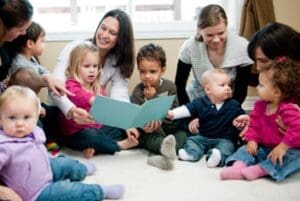Meet your child’s needs with relationship-based care
Relationships are often rooted and nurtured within the comforting walls of our own home during our children’s first years of life. It’s sometimes all too easy to forget that non-parental care plays a monumental role in our children’s lives as well.
 According to the Network of Infant Toddler Researchers approximately 50 percent of infants, babies, and toddlers are placed in center-based care. Child care providers are integrated into our children’s daily routines, which has a direct effect on developmental characteristics and relationship styles.
According to the Network of Infant Toddler Researchers approximately 50 percent of infants, babies, and toddlers are placed in center-based care. Child care providers are integrated into our children’s daily routines, which has a direct effect on developmental characteristics and relationship styles.
The Network of Infant Toddler Researchers highly recommends integrating a relationship-based care practice within early child care and educational centers. The goal is to increase sensitive and responsive caregiving, leading to long-term success and development.
A relationship-based approach is structured with multiple components that ultimately cement relationships between staff and the children in their care. A setting with a relationship-based approach is modeled off of two pillars of support: primary caregiving and continuity of care.
Primary caregiving refers to one caregiver who is responsible for a small group of children, opposed to a large classroom setting. This type of caregiving allows for a more intimate connection, thus delivering high-quality education and more intimate relationship with children’s families. The primary caregiver aspect of the relationship-based approach establishes a sense of security and more open style of communication. Usage of open communication in the parent-caregiver relationship is invaluable because it encourages trust, cultural sensitivity and celebration of developmental milestones.
Continuity of care, the second pillar in the relationship-based care approach, encourages that children have a relationship with their caregiver for an extended period of time. Families often change their child’s caregiver based on age and developmental pace. However, when a child experiences continuity of care, the quality of the relationship dramatically increases. Studies show that when children lack a sense of stability from their caregiver, they are more likely to experience social-emotional challenges.
Quality of child care is most notably recognized by the number of staff, group size and level of teacher education. Healthy development is often reflected by a balance of these educational factors. Children ages birth to 5 rely on positively-established relationships with caregivers to successfully trust, explore and learn.
A heightened knowledge of the importance of relationship-based approaches encourages parents and policy makers to take the necessary steps to ensure that the quality of their child’s care and education is strengthened.
Learn more about our programs that support relationship-based care.
All content in this article, including any advice or commentary from Southwest Human Development staff and/or others, should be considered an opinion and is provided for informational purposes only. The content is not intended to be a substitute for medical or other professional advice, diagnosis or treatment. Always seek the direct advice of your own trusted professional with any questions or concerns you may have regarding the child/ren in your care. Southwest Human Development does not recommend or endorse any specific tests, products, procedures or other information that may be mentioned in this article. You may contact Southwest Human Development’s Birth to Five Helpline at 1-877-705-KIDS (5437) to speak with one of our early childhood professionals for personalized assistance. Birth to Five Helpline specialists are available Monday through Friday from 8 a.m. to 8 p.m.


